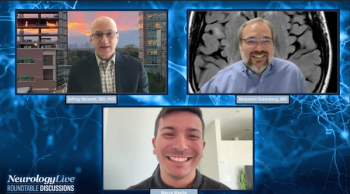
Patients reported increased good ON time and improved confidence in daily activities while experiencing a lower treatment burden compared to their previous medication regimens.

Marco Meglio, Assistant Managing Editor for NeurologyLive, has been with the team since October 2019. Follow him on Twitter @marcomeglio1 or email him at [email protected]

Patients reported increased good ON time and improved confidence in daily activities while experiencing a lower treatment burden compared to their previous medication regimens.

Test your neurology knowledge with NeurologyLive®'s weekly quiz series, featuring questions on a variety of clinical and historical neurology topics. This week's topic is on cryptogenic stroke.

Lu AF84222 was considered well tolerated, with greater treatment effects observed in a subgroup of patients with less impaired multiple system atrophy.

Despite showing no differences vs placebo on the primary end point of gait parameters, TAK-071-treated patients demonstrated significant improvements in global cognition score.

Change from baseline in Myasthenia Gravis Activities of Daily Living score was statistically significant for inebilizumab-treated patients and the therapy showed a safe and well-tolerated profile without new safety signals.

Tim Miller, MD, director of functional neurosurgery at the Marcus Neuroscience Institute, Baptist Health, provided commentary on the use of HIFU as a non-invasive treatment for patients with essential tremor and specific types of Parkinson disease.

Results from the phase 3 TEMPO-2 trial, an additional study assessing tavapadon as a flexible-dose monotherapy, are expected by the end of this year.

A pair of neurologists from the University of California, Irvine, detailed some of the training and career focuses of large federal agencies in effort to address the shortage of neurologists. [WATCH TIME: 4 minutes]

RNS60 may lengthen survival by slowing FVC progression, particularly in participants with low NfL and MCP-1 levels at baseline, suggesting a potential target subgroup for future studies.

The company expects to complete the trial in Q1 2025 and anticipates it will use the feedback from regulators to guide an accelerated approval.

Recruitment for the OCTOPUS trial, which explores alpha-lipoic acid and metformin in progressive multiple sclerosis (MS), is progressing well with nearly half of participants in stage 1 already randomized.

Representatives from the SCN8A Alliance discussed ways to improve the quality of life for children with SCN8A-related epilepsy, highlighting the critical role of early genetic diagnosis and targeted interventions. [WATCH TIME: 4 minutes]

In the study, patients with spinocerebellar ataxia treated with troriluzole demonstrated statistically significant improvements at years 1 and 2 on the treatment.

Stewart Tepper, MD, Vice President at the New England Institute for Neurology and Headache in Stamford, Connecticut, provided commentary on a wide-scale analysis of nearly 5000 patients testing the effects of rimegepant.

In the ULTIMATE study subgroup, ublituximab consistently lowered disease activity in MS patients, suggesting the MSDA test may effectively assess therapeutic efficacy.

Test your neurology knowledge with NeurologyLive®'s weekly quiz series, featuring questions on a variety of clinical and historical neurology topics. This week's topic is on myasthenia gravis.

In the original phase 3 studies, treatment with ozanimod resulted in significant reductions in clinical relapses and lesion counts on MRI as well as slowed brain volume loss relative to intramuscular interferon-β-1a.

Towards the end of ofatumumab dosing, administered monthly via subcutaneous injection, patients noted issues like fatigue, cognitive impairment, and gait difficulties.

A phase 3 trial revealed that simvastatin, while safe, did not significantly slow disability progression in patients with non-active secondary progressive MS.

The randomized phase 3 trial will test the hypothesis that the initiation of azathioprine after a first attack of MOGAD could prevent further relapse and disability accrual.

Mind Moments®, a podcast from NeurologyLive®, brings you an exclusive interview with Joanne Donovan, MD, PhD. [LISTEN TIME: 20 minutes]

The 2-year study highlighted the potential of cladribine to promote remyelination in highly active relapsing-remitting MS, particularly when early disease control is achieved.

In this episode, a pair of neuroimmune experts discussed some of the emerging research for patients with MOGAD, highlighting the need for immunological markers, remodeling therapies, and enhancements to diagnostic criteria. [WATCH TIME: 5 minutes]

The pair of neurologists provided clinical insight on a number of lingering non-treatment unmet needs for patients with MOGAD, including improved care for pediatric patients and underreported complications like sleep disturbances and genitourinary issues in adults. [WATCH TIME: 5 minutes]

In this discussion, the pair of neurologists explore the latest drug development and ongoing clinical trials for MOGAD, a rare neuroimmune disorder. [WATCH TIME: 4 minutes]

In this segment, Bennett and Greenberg explore the diagnosis, acute treatment, and long-term management of MOGAD, highlighting current therapies and ongoing research. [WATCH TIME: 8 minutes]

Known as QRL-101-03, the phase 1 study is expected to include 60 healthy participants, with topline results expected in the first half of 2025.

A pair of neurologists from the University of California, Irvine, provided commentary on the ways to help young investigators find their footing in research settings, and exposing them to opportunities major governmental agencies can provide. [WATCH TIME: 4 minutes]

BMB-101, a 5-HT2C receptor agonist, will be tested in a cohort of 20 adults aged 18 to 65 with absence epilepsy or a developmental encephalopathy for an 8-to-12-week treatment period.

In this episode, Greenberg and Bennett provide some perspective on the fluidity of MOGAD diagnosis and how it could potentially change over time as more is understood about neuroimmune disorders. [WATCH TIME: 5 minutes]